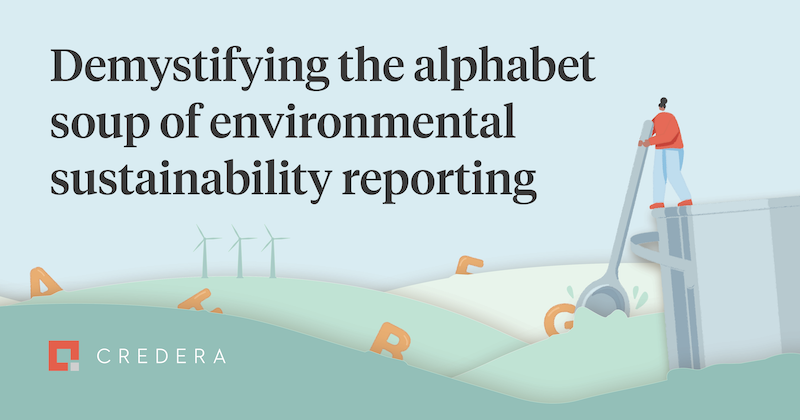Data
May 26, 2023
Demystifying the alphabet soup of environmental sustainability reporting

In recent years, environmental sustainability has become a critical focus for organisations worldwide. Companies of every size and across every industry have been forced to consider the impact of their operations on the environment and society as a whole and have established goals for improvement. But what sustainability means, the chosen pathways for action, and how to report progress can be as unique as the organisation itself.
As a result, various groups and frameworks have emerged to establish standards for sustainability reporting. While they have the common goal of enabling more streamlined, cohesive, and comprehensive reporting, the slight differences and nuances of each organisational approach can be difficult to navigate when crafting a long-term environmental sustainability strategy.
In this article, we will demystify four major groups’ roles in the environmental sustainability space, explore their unique reporting focuses, and provide guidance on how to incorporate them into a cohesive environmental sustainability strategy.
1. The Greenhouse Gas Protocol

The Greenhouse Gas Protocol (GHGP) is a widely accepted methodology for measuring and reporting greenhouse gas emissions, developed by the World Resources Institute (WRI) and the World Business Council for Sustainable Development (WBCSD). Rather than being an organisation that businesses actively report to or interface with, the GHGP is essentially a set of accounting standards that has largely become the worldwide default for the practice of carbon accounting.The GHGP is divided into three scopes to categorise emissions:
Scope 1: Direct emissions from owned or controlled sources.
Scope 2: Indirect emissions from the generation of purchased energy.
Scope 3: All other indirect emissions from activities of the organisation.

Examples of Scope 1, 2, and 3 emissions under the GHG Protocol.
Under this protocol, the emissions levels of various types of greenhouse gases (GHG), such as methane, nitrous oxide, or hydrofluorocarbons (HFCs), are converted into units of carbon dioxide equivalents (CO2e) based on their environmental impact relative to carbon dioxide, the most common greenhouse gas. This consolidation makes it easier to compare and track environmental impact across different organisations or industries.
According to WRI, more than 90% of Fortune 500 companies use the GHGP to measure and manage their emissions. By adopting the GHG Protocol's standardised methodology, organisations can establish a solid emissions baseline, identify reduction opportunities, and track progress over time using a widely accepted set of standards.
2. The Carbon Disclosure Project

The Carbon Disclosure Project (CDP) is a nonprofit organisation that collects sustainability data from over 18,500 companies worldwide, offering business stakeholders valuable insights into a company's carbon footprint. By participating in the CDP, organisations can increase transparency regarding their environmental impact and attract investors who prioritise sustainability. Moreover, the CDP provides a platform for companies to benchmark their performance against peers and identify best practices for emissions reduction.
The CDP sponsors a variety of programmes to serve the interest of its signatory investors, including programmes to combat deforestation, report GHG emissions for both corporations and cities, and examine water usage and waste. The CDP also provides snapshot scores across categories including disclosure, awareness, management, and leadership to incentivise organisations to consider their environmental sustainability strategy more holistically.
3. The Science-Based Targets initiative
The Science-Based Targets initiative (SBTi) is a collaboration between the United Nations Global Compact (UNGC), the World Wide Fund for Nature (WWF), the CDP, and WRI. The Paris Agreement, a landmark international treaty adopted in 2015, aimed to strengthen the global response to the threat of climate change by keeping this century’s global temperature rise well below 2 degrees Celsius above pre-industrial levels, as well as pursuing efforts to limit the temperature increase even further to 1.5 degrees Celsius. The SBTi provides a framework for companies to set ambitious, science-based targets to reduce their greenhouse gas emissions in line with the Paris Agreement’s goals and currently works with over 400 companies of all sizes. Companies going through the target validation process (see graphic below) benefit from detailed feedback and support from the SBTi’s technical experts, who constantly push these companies to aim for higher environmental sustainability goals, rather than allowing achievements to serve as a justification for inaction.

The SBTi’s target validation process.
4. The Task Force on Climate-related Financial Disclosures

The Task Force on Climate-related Financial Disclosures (TCFD) was established by the Financial Stability Board in response to a perceived lack of transparency around reporting and disclosure standards in the wake of the Paris Agreement. It offers recommendations and standards for companies to disclose climate-related risks and opportunities in their financial reporting, helping organisations better understand the financial implications of climate change and informing investors, lenders, and insurers about the company's climate resilience. The reporting framework includes governance, strategy, risk management, and metrics and targets.
Crucially, the TCFD framework is quickly becoming the preferred reporting standard for regulators around the world; one example is the Streamlined Energy and Carbon Reporting (SECR) programme in the UK, which applies to all companies above a certain size. Adopting the TCFD framework supports organisations in managing climate-related risks and seizing opportunities arising from the transition to a low-carbon economy.
How to choose which organisations to report to
To determine which or how many of these groups to align with, consider the following three factors:
1. Level of ambition
Assess your company's commitment to sustainability and the level of ambition you aim to achieve. If your company seeks to adopt a more aggressive and science-based approach to reducing emissions in line with the goals of the Paris Agreement, or has even higher goals of achieving carbon neutrality, the SBTi provides a comprehensive framework for setting such ambitious targets.
On the other hand, if your company's focus is on systematically tracking, managing, and reducing GHG emissions to simply comply with industry standards and regulations without explicitly aligning with the Paris Agreement, the GHG Protocol and CDP can provide essential frameworks, methodologies, and benchmarks for emissions reporting and performance comparison. The most ambitious organisations may choose to align sustainability goals to those of multiple reporting agencies to ensure their reporting is as comprehensive as possible.
2. Regulatory environment
The environmental sustainability regulatory landscape varies greatly across different parts of the world and industries and can be a substantial factor in selecting an appropriate reporting organisation to align with. Some organisations' frameworks may be mandatory in certain regions or may become so in the future.
For example, the GHG Protocol is widely recognised and has been adopted by many regulatory bodies and industry associations for emissions accounting and reporting (see graphic below). In the United States, the Securities and Exchange Commission (SEC) has been increasingly emphasising the importance of disclosing material climate-related risks in financial filings. In May 2022, it proposed a rule that would require registrants to include certain climate-related disclosures in their registration statements and periodic reports, indirectly encouraging companies to adopt a framework such as the TCFD for comprehensive reporting. A finalised rule incorporating feedback from the public is expected to be released in the coming months. In the UK, the Sustainable Disclosure Requirement is set to take effect this year and will require the use of the TCFD framework explicitly.

3. Industry standards and competition
Companies must also carefully evaluate industry-specific standards and the practices of their competitors. Those operating in sectors with high emissions or facing intense competition may benefit from adopting multiple reporting frameworks to demonstrate leadership in sustainability.
In the automotive industry, where electrification and emissions reduction are critical competitive factors, companies like Tesla and Volkswagen have adopted SBTi targets to showcase their commitment to reducing emissions. Similarly, companies in the energy industry, where environmental concerns are at the forefront, have sought to establish themselves as leaders in the journey to carbon neutrality. First Solar, a U.S.-based solar panel manufacturer, tracks metrics in areas like recycling, supply chain transparency, and carbon and water footprint through its initiative Responsible Solar. Schneider Electric, a French company specialising in energy management and digital automation, has made ambitious commitments in areas including carbon neutrality and biodiversity.
Making your environmental sustainability reporting decision
Navigating the landscape of environmental sustainability can be challenging. Your organisation’s level of ambition, regulatory environment, and industry standards must all be considered when determining which group or groups to align with.
We’ve worked together with organisations by sharing our expertise to help them formulate and understand their environmental sustainability goals. We then work with them to craft long-term strategies to make those goals achievable—whether through selecting the right reporting standards, creating a roadmap, or choosing a data platform and carbon accounting tool to track carbon emissions. By incorporating these standards into a cohesive sustainability strategy, organisations can not only improve environmental performance, but also attract environmentally conscious investors, enhance their reputations, and create long-term value.
Ultimately, choosing the right sustainability frameworks and organisations will empower your company to drive meaningful change and contribute to a more sustainable future. Please get in touch with a member of our team to find out more.
Contact Us
Ready to achieve your vision? We're here to help.
We'd love to start a conversation. Fill out the form and we'll connect you with the right person.
Searching for a new career?
View job openings

